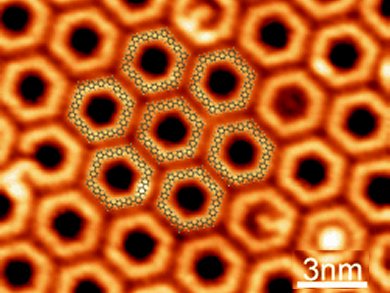Researchers in China and Germany have used surface-assisted synthesis to produce large macrocycles comprising 18 phenylene units. The team, which was led by Junfa Zhu and J. Michael Gottfried, reacted 4,4”-dibromo-m-terphenyl on a Cu(111) surface under ultrahigh-vacuum conditions. When this multiple C−C Ullmann coupling reaction was carried out at 300 K, zigzag chains of C−Cu−C coordination polymers were formed, but when the reaction temperature was raised to 55 0K, ordered arrays of hexagonal rings were produced, as well as other structures.
Scanning tunneling microsope (STM) images showed that each ring has a diameter of 21.3 Å and thus consists of six m-terphenylene fragments, that is, 18 phenylene groups. The macrocycles aggregate to form ordered arrays with a hexagonal unit cell. Most of the macrocycles are empty, but the STM images showed that circular objects were present in some of the cavities. The surface-assisted technique is the only method reported to date that can be used for the synthesis of such macrocyclic arrays.
The researchers predict that these “nanotroughs” could be used to enclose quantum dots or large organic molecules.
- Surface-Assisted Organic Synthesis of Hyperbenzene Nanotroughs,
Qitang Fan, Cici Wang, Yong Han, Junfa Zhu, Wolfgang Hieringer, Julian Kuttner, Gerhard Hilt, J. Michael Gottfried,
Angew. Chem. Int. Ed. 2013.
DOI: 10.1002/anie.201300610




